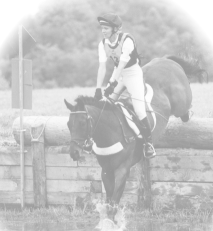|
|
|
|

|
|
|
|
 Dressage Dressage |
| The first test is called a "dressage"
test. Dressage is a French word meaning training. Originally designed to
show the horse's capability on the parade ground in performing various
movements involved with reviewing troops, today the dressage test comprises
a set series of complicated movements performed in an enclosed arena. Precision,
smoothness, suppleness and complete obedience show off the horse's gymnastic
development. Ideally it should look as if the horse is performing of its
own accord, carrying its rider in complete balance. The test is scored
on each movement, rather like the scoring in figure skating, with the overall
harmony and precision of the whole exercise
taken into consideration. Dressage is very important to the three-day event rider as it aids in conditioning the horse's muscles for the endurance test. The horse becomes fit and strong, while its muscles gain elasticity to lengthen and shorten at a gallop. The purpose of the dressage test is to demonstrate the horse and rider's ability to perform each movement with balance, suppleness and precision. |
 Cross
Country Cross
Country |
| The second discipline in the three-day
event is the endurance test, which proves the speed, endurance, courage
and jumping ability of the true cross-country horse brought to the peak
of condition. At the same time, it demonstrates the rider's knowledge of
pace and riding at speed over cross-country obstacles.
The endurance test is comprised of Phase A - roads and tracks; Phase B - steeplechase; Phase C - roads and tracks; and Phase D - cross-country. Each phase must be completed in a given time. Phase A of the roads and tracks is a warm-up period, usually done at a brisk trot, for the purpose of relaxing and loosening up both horse and rider. Promptly at the finish of Phase A, the horse and rider continue on to Phase B, the steeplechase, ridden at a full gallop up to speeds of 24 miles per hour while also jumping six to eight jumps. At the end of the steeplechase, the horse and rider go directly into Phase C, the second roads and tracks. This phase is very important in allowing the horse to rest while bringing his heart rate and breathing back to normal. The pace is usually a quiet trot, interspersed with periods of walking and an occasional relaxed canter. The end of Phase C brings the pair to the start of Phase D, the cross-country. Here the horse has a compulsory 10-minute rest, allowing a panel of judges and veterinarians to check the horse's temperature, pulse, respiration and soundness. If, in the opinion of the panel, the horse is not fit or sound enough to continue, he must be withdrawn from the competition. Those which pass the inspection go to the starting box for Phase D, to begin the most exciting part of the endurance test. The cross-country course, ridden at a strong gallop, can be from 2.5 to 4 miles long and contains 24-36 solid jumping obstacles of great variety. The course is built to be just as challenging as the terrain. Each combination of horse and rider must complete all four phases in the proper order and within the time allowed, in order to not accrue any penalties. In Olympic and World competition, the distance covered on the speed and endurance phase can be 20 miles. The cross-country is the phase that appeals most to spectator and rider alike. Unlike other sports, where only the human will and body are working against the clock, in combined training two minds and bodies have to work as one. As an additional attraction, combined training is the only high-risk Olympic sport that permits men and women to compete as equals. |
 Show
Jumping Show
Jumping |
| The third and final test takes place in
the jumping arena. After the demands of the speed and endurance phases,
horses undergo a thorough veterinary examination for soundness before they
begin show jumping. A series of painted fences in the ring have to be negotiated
before the full three days of competition are finally over. In the words
of the F.E.I. rule book: "The test on the third day is not an ordinary
show jumping competition ... Its sole object is to demonstrate that, on
the day after a severe test of endurance, the horses have retained the
suppleness, energy and obedience necessary for them to continue in service."
The show jumping course usually consists of between 12 and 15 obstacles, including at least one combination, several spread fences and, in some cases, a ditch or water jump. The show jumping courses are designed to test the horse's and rider's ability to negotiate a variety of fences, of various heights, widths and combinations, meeting all fences with the proper distance and approach. This requires the horse to be balanced and supple for tight turns and short distances between fences. For the spectator, this sport is both exciting and breath-taking to watch, as just one single rail knocked down can change the standings dramatically. At the end of the competition, penalties for all the competitors are totaled. Each test is scored individually then added together for the final result. The competitor with the fewest overall penalties is the victor! |
Information courtesy of USCTA